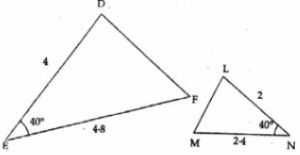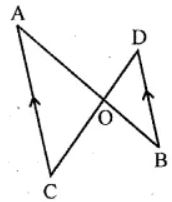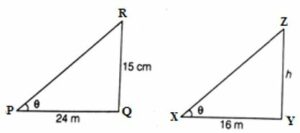ML Aggarwal Similarity Exe-13.1 Class 10 ICSE Maths Solutions. We Provide Step by Step Answer of Exe-13.1 Questions for Similarity as council prescribe guideline for upcoming board exam. Visit official Website CISCE for detail information about ICSE Board Class-10.
ML Aggarwal Similarity Exe-13.1 Class 10 ICSE Maths Solutions
| Board | ICSE |
| Subject | Maths |
| Class | 10th |
| Chapter-13 | Similarity |
| Writer / Book | Understanding |
| Topics | Solutions of Exe-13.1 |
| Academic Session | 2024-2025 |
Similarity Exe-13.1 Questions
ML Aggarwal Class 10 ICSE Maths Solutions
Question 1. State which pairs of triangles in the figure given below are similar. Write the similarity rule used and also write the pairs of similar triangles in symbolic form (all lengths of sides are in cm):

Answer :
Given
(i) In ∆ABC and PQR
AB/PQ = 3.2/4 = 4/5
AC/PR = (3.6/4.5) = 4/5
BC/QR = 3/5.4 = 5/9
(ii) In ∆DEF and ∆LMN
∠E = ∠N = 40°
DE/LN = 4/2 = 2/1 and
EF/MN = 4.8/2.4
= 2/1
∴ ∆DEF ~ ∆LMN (SAS axiom)
Question 2. If in two right triangles, one of the acute angle of one triangle is equal to an acute angle of the other triangle, can you say that the two triangles are similar? Why?
Answer :
In two right triangles,
one of the acute angles of the one triangle is
equal to an acute angle of the other triangle.
The triangles are similar. (AAA axiom)
Question 3. It is given that ∆ABC ~ ∆EDF such that AB = 5 cm, AC = 7 cm, DF = 15 cm and DE = 12 cm.
Find the lengths of the remaining sides of the triangles.
Answer :

∆ABC ~ ∆EDF
AB = 5 cm, AC = 7 cm, DF = 15 cm and DE = 12 cm
ΔDEF ~ ΔLMN
So, AB/ED = AC/EF = BC/DF
Consider AB/ED = AC/EF
5/12 = 7/EF
By cross multiplication,
EF = (7 × 12)/5
EF = 16.8 cm
Now, consider AB/ED = BC/DF
5/12 = BC/15
BC = (5 × 15)/12
BC = 75/12
BC = 6.25
Question 4.
(a) If ∆ABC ~ ∆DEF, AB = 4 cm, DE = 6 cm, EF = 9 cm and FD = 12 cm, then find the perimeter of ∆ABC.
(b) If ∆ABC ~ ∆PQR, Perimeter of ∆ABC = 32 cm, perimeter of ∆PQR = 48 cm and PR = 6 cm, then find the length of AC.
Answer :

(a) ∆ABC ~ ∆DEF
AB = 4 cm, DE = 6 cm, EF = 9 cm and FD = 12 cm
Let ΔABC ~ ΔDEF
So, AB/DE = AC/DF = BC/EF
Consider, AB/DE = AC/DE
4/6 = AC/12
By cross multiplication we get,
AC = (4 × 12)/6
AC = 48/6
AC = 8 cm
Then, consider AB/DE = BC/EF
4/6 = BC/9
BC = (4 × 9)/6
BC = 36/6
BC = 6 cm
Therefore, the perimeter of ΔABC = AB + BC + AC
= 4 + 6 + 8
= 18 cm
(b)
∆ABC ~ ∆PQR
Perimeter of ∆ABC = 32 cm
Perimeter of ∆PQR = 48 cm
So, AB/PQ = AC/PR = BC/QR
Then, perimeter of ∆ABC/perimeter of ∆PQR = AC/PR
32/48 = AC/6
AC = (32 × 6)/48
AC = 4
Therefore, the length of AC = 4 cm.
Question 5. Calculate the other sides of a triangle whose shortest side is 6 cm and which is similar to a triangle whose sides are 4 cm, 7 cm and 8 cm.
Answer :

Let ∆ABG ~ ∆DEF in which shortest side of
∆ABC is BC = 6 cm.
In ∆DEF, DE = 8 cm, EF = 4 cm and DF = 7 cm
∆ABC is BC = 6cm
∆ABC ~ ∆DEF
So, AB/DE = BC/EF = AC/DF
Consider AB/DE = BC/EF
AB/8 = 6/4
AB = (6 × 8)/4
AB = 48/4
AB = 12
Now, consider BC/EF = AC/DF
6/4 = AC/7
AC = (6 × 7)/4
AC = 42/4
AC = 21/2
AC = 10.5 cm
Question 6.
(a) In the figure given below, AB || DE, AC = , 3 cm, CE = 7.5 cm and BD = 14 cm. Calculate CB and DC.

(b) In the figure (2) given below, CA || BD, the lines AB and CD meet at G.
(i) Prove that ∆ACO ~ ∆BDO.
(ii) If BD = 2.4 cm, OD = 4 cm, OB = 3.2 cm and AC = 3.6 cm, calculate OA and OC.

Answer :
(a) In the given figure,
AB||DE, AC = 3 cm, CE = 7.5 cm, BD = 14 cm
From the question it is given that,
AB||DE
AC = 3 cm
CE = 7.5 cm
BD = 14 cm
From the figure,
∠ACB = ∠DCE [because vertically opposite angles]
∠BAC = ∠CED [alternate angles]
Then, ∆ABC ~ ∆CDE
So, AC/CE = BC/CD
3/7.5 = BC/CD
By cross multiplication we get,
7.5BC = 3CD
Let us assume BC = x and CD = 14 – x
7.5 × x = 3 × (14 – x)
7.5x = 42 – 3x
7.5x + 3x = 42
10.5x = 42
x = 42/10.5
x = 4
Therefore, BC = x = 4 cm
CD = 14 – x
= 14 – 4
= 10 cm
(i) We have to prove that, ∆ACO ~ ∆BDO.
So, from the figure
Consider ∆ACO and ∆BDO
Then,
∠AOC = ∠BOD [from vertically opposite angles]
∠A = ∠B
Therefore, ∆ACO = ∆BDO
Given, BD = 2.4 cm, OD = 4 cm, OB = 3.2 cm, AC = 3.6 cm,
∆ACO ~ ∆BOD
So, AO/OB = CO/OD = AC/BD
Consider AC/BD = AO/OB
3.6/2.4 = AO/3.2
AO = (3.6 × 3.2)/2.4
AO = 4.8 cm
Now, consider AC/BD = CO/OD
3.6/2.4 = CO/4
CO = (3.6 × 4)/2.4
CO = 6 cm
Question 7.
(a) In the figure
(i) given below, ∠P = ∠RTS.
Prove that ∆RPQ ~ ∆RTS.
(b) In the figure
(ii) given below,
∠ADC = ∠BAC. Prove that CA² = DC x BC.

Answer :
(a) In the given figure, ∠P = ∠RTS
To prove : ∆RPQ ~ ∆RTS
Proof : In ∆RPQ and ∆RTS
∠R = ∠R (common)
∠P = ∠RTS (given)
∆RPQ ~ ∆RTS (AA axiom)
(b)
From the figure, ∠ADC = ∠BAC
So, we have to prove that, CA² = DC x BC
In ∆ABC and ∆ADC
∠C = ∠C (common angle for both triangle)
∠BAC = ∠ADC (from the question)
∆ABC ~ ∆ADC
Therefore, CA/DC = BC/CA
We know that, corresponding sides are proportional,
Therefore, CA2 = DC × BC
Question 8.
(a) In the figure (1) given below, AP = 2PB and CP = 2PD.
(i) Prove that ∆ACP is similar to ∆BDP and AC || BD.
(ii) If AC = 4.5 cm, calculate the length of BD.
(b) In the figure (2) given below,
∠ADE = ∠ACB.
(i) Prove that ∆s ABC and AED are similar.
(ii) If AE = 3 cm, BD = 1 cm and AB = 6 cm, calculate AC.
(c) In the figure (3) given below, ∠PQR = ∠PRS. Prove that triangles PQR and PRS are similar. If PR = 8 cm, PS = 4 cm, calculate PQ.
figure see in your textbook
Answer :
In the given figure,
AP = 2PB, CP = 2PD
To prove:
(a) From the question it is give that,
AP = 2PB, CP = 2PD
(i) We have to prove that, ∆ACP is similar to ∆BDP and AC || BD
AP = 2PB
AP/PB = 2/1
Then, CP = 2PD
CP/PD = 2/1
∠APC = ∠BPD [from vertically opposite angles]
So, ∆ACP ~ ∆BDP
Therefore, ∠CAP = ∠PBD [alternate angles]
Hence, AC || BD
(ii) AP/PB = AC/BD = 2/1
AC = 2BD
2BD = 4.5 cm
BD = 4.5/2
BD = 2.25 cm
(b)
From the given figure,
(i) ∠A = ∠A (common angle for both triangles)
∠ACB = ∠ADE [given]
Therefore, ∆ABC ~ ∆AED
(ii) from (i) proved that, ∆ABC ~ ∆AED
So, BC/DE = AB/AE = AC/AD
AD = AB – BD
= 6 – 1 = 5
Consider, AB/AE = AC/AD
6/3 = AC/5
AC = (6 × 5)/3
AC = 30/3
AC = 10 cm
(c)
∠P = ∠P (common angle for both triangles)
∠PQR = ∠PRS [from the question]
So, ∆PQR ~ ∆PRS
Then, PQ/PR = PR/PS = QR/SR
Consider PQ/PR = PR/PS
PQ/8 = 8/4
PQ = (8 × 8)/4
PQ = 64/4
PQ = 16 cm
Similarity Exe-13.1 Questions
ML Aggarwal Class 10 ICSE Maths Solutions
Page-263
Question 9. In the given figure, ABC is a triangle in which AB = AC. P is a point on the side BC such that PM ⊥ AB and PN ⊥ AC. Prove that BM x NP = CN x MP.

Answer :
In the given figure, ABC in which AB = AC.
P is a point on BC such that PM ⊥ AB and PN ⊥ AC
To prove : BM x NP = CN x MP
Consider the ∆ABC
AB = AC … [from the question]
∠B = ∠C … [angles opposite to equal sides]
Then, consider ∆BMP and ∆CNP
∠M = ∠N
Therefore, ∆BMP ~ ∆CNP
So, BM/CN = MP/NP
By cross multiplication we get,
BM x NP = CN x MP
Hence it is proved.
Question 10. Prove that the ratio of the perimeters of two similar triangles is the same as the ratio of their corresponding sides.
Answer :
Given : ∆ABC ~ ∆PQR .
To prove : Ratio in their perimeters k
the same as the ratio in their corresponding sides.
From the question it is given that, two triangles are similar triangles
So, ∆MNO ~ ∆XYZ
If two triangles are similar, the corresponding angles are equal and their corresponding sides are proportional.
MN/XY = NO/YZ = MO/XZ
Perimeter of ∆MNO = MN + NO + MO
Perimeter of ∆XYZ = XY + YZ + XZ
Therefore, (MN/XY = NO/YZ = MO/XZ) = (MN/XY + NO/YZ + MO/XZ)
= Perimeter of ∆MNO/perimeter of ∆XYZ
Question 11. In the adjoining figure, ABCD is a trapezium in which AB || DC. The diagonals AC and BD intersect at O. Prove that 

Using the above result, find the value(s) of x if OA = 3x – 19, OB = x – 4, OC = x – 3 and OD = 4.
Answer :
ABCD is a trapezium in which AB || DC
Diagonals AC and BD intersect each other at O.
we have to prove that, AO/OC = BO/OD
Consider the ∆AOB and ∆COD,
∠AOB = ∠COD … [vertically opposite angles]
∠OAB = ∠OCD
Hence, ∆AOB ~ ∆COD
So, OA/OC = OB/OD
Now by using above result we have to find the value of x if OA = 3x – 19, OB = x – 4, OC = x – 3 and OD = 4.
OA/OC = OB/OD
(3x – 19)/(x – 3) = (x – 4)/4
By cross multiplication we get,
(x – 3) (x – 4) = 4(3x – 19)
X2 – 4x – 3x + 12 = 12x – 76
X2 – 7x + 12 – 12x + 76 = 0
X2 – 19x + 88 = 0
X2 – 8x – 11x + 88 = 0
X(x – 8) – 11(x – 8) = 0
(x – 8) (x – 11) = 0
Take x – 8 = 0
X = 8
Then, x – 11= 0
X = 11
Hence, the value of x is 8 and 11.
Question 12.
(a) In the figure given below, AB, EF and CD are parallel lines. Given that AB =15 cm, EG = 5 cm, GC = 10 cm and DC = 18 cm. Calculate
(i) EF
(ii) AC.

(b) In the figure given below, AF, BE and CD are parallel lines. Given that AF = 7.5 cm, CD = 4.5 cm, ED = 3 cm, BE = x and AE = y. Find the values of x and y.

Answer :
(a) In the given figure,
AB || EF || CD
AB = 15 cm, EG = 5 cm, GC = 10 cm and DC = 18 cm
Calculate :
(i) Consider the ∆EFG and ∆CGD
∠EGF = ∠CGD [Because vertically opposite angles are equal]
∠FEG = ∠GCD [alternate angles are equal]
Therefore, ∆EFG ~ ∆CGD
Then, EG/GC = EF/CD
5/10 = EF/18
EF = (5 × 18)/10
Therefore, EF = 9 cm
(ii) Now, consider the ∆ABC and ∆EFC
EF ||AB
So, ∆ABC ~ ∆EFC
Then, AC/EC = AB/EF
AC/(5 + 10) = 15/9
AC/15 = 15/9
AC = (15 × 15)/9
Hence, AC = 25 cm
(b)
Consider the ∆AEF and ∆CED
∠AEF and ∠CED [because vertically opposite angles are equal]
∠F = ∠C [alternate angles are equal]
Therefore, ∆AEF ~ ∆CED
So, AF/CD = AE/ED
7.5/4.5 = y/3
By cross multiplication,
y = (7.5 × 3)/4.5
y = 5 cm
So, similarly in ∆ACD, BE ||CD
Therefore, ∆ABE ~ ∆ACD
EB/CD = AE/AD
x/CD = y/y + 3
x/4.5 = 5/(5 + 3)
x/4.5 = 5/8
x = (4.5 × 5)/8
x = 22.5/8
x = 225/80
x = 45/16
x = 2(13/16)
Similarity Exe-13.1 Questions
ML Aggarwal Class 10 ICSE Maths Solutions
Page-264
Question 13. In the given figure, ∠A = 90° and AD ⊥ BC If BD = 2 cm and CD = 8 cm, find AD.

Answer :
So, ∠A = 90o
And AD ⊥ BC
∠BAC = 90o
Then, ∠BAD + ∠DAC = 90o … [equation (i)]
Now, consider ∆ADC
∠ADC = 90o
So, ∠DCA + ∠DAC = 90o … [equation (ii)]
From equation (i) and equation (ii)
We have,
∠BAD + ∠DAC = ∠DCA + ∠DAC
∠BAD = ∠DCA … [equation (iii)]
So, from ∆BDA and ∆ADC
∠BDA = ∠ADC … [both the angles are equal to 90o]
∠BAD = ∠DCA … [from equation (iii)]
Therefore, ∆BDA ~ ∆ADC
BD/AD = AD/DC = AB/AC
Because, corresponding sides of similar triangles are proportional
BD/AD = AD/DC
By cross multiplication we get,
AD2 = BD × CD
AD2 = 2 × 8 = 16
AD = √16
AD = 4
Question 14. A 15 metres high tower casts a shadow of 24 metres long at a certain time and at the same time, a telephone pole casts a shadow 16 metres long. Find the height of the telephone pole.
Answer :

Height of a tower AB = 15 m
and its shadow BC = 24 m
At the same time and position
Let the height of a telephone pole DE = x m
and its shadow EF = 16 m
∆PQR ~ ∆MNO
Therefore, PQ/MN = ON/RQ
15/x = 24/16
By cross multiplication we get,
x = (15 × 16)/24
x = 240/24
x = 10
Hence, height of pole = 10 m.
Question 15. A street light bulb is fixed on a pole 6 m above the level of street. If a woman of height casts a shadow of 3 m, find how far she is away from the base of the pole?
Answer :
Height of height pole(AB) = 6m
and height of a woman (DE) = 1.5 m
Here shadow EF = 3 m .
Hence, pole and woman are standing in the same line
PM ||MR
∆PRQ ~ ∆MNR
So, RQ/RN = PQ/MN
(3 + x)/3 = 6/1.5
(3 + x)/3 = 60/15
(3 + x)/3 = 4/1
(3 + x) = 12
X = 12 – 3
X = 9m
Hence, women is 9m away from the pole.
— : End of ML Aggarwal Similarity Exe-13.1 Class 10 ICSE Maths Solutions : –
Return to: ML Aggarwal Solutions for ICSE Class-10
Thanks
Please Share with Your Friends




17 2 EX 13.1 WHEN CROSS MULTIPLICATION IS DONE ANSWER IS DIFFERENT AND WHEN ANSWER TAKEN OUT ANSWER IS DIFFERENT
which questions number of exe-13.1 of similarity ml aggarwal class 10
In 13.1 question 14 u messed up with the names of triangle please can you go through.
we will look into matter